Items tagged with 'NYS Department of Environmental Conservation'
The High Peaks are crowded, so the DEC would like to promote "sustainable tourism" in the Adirondacks
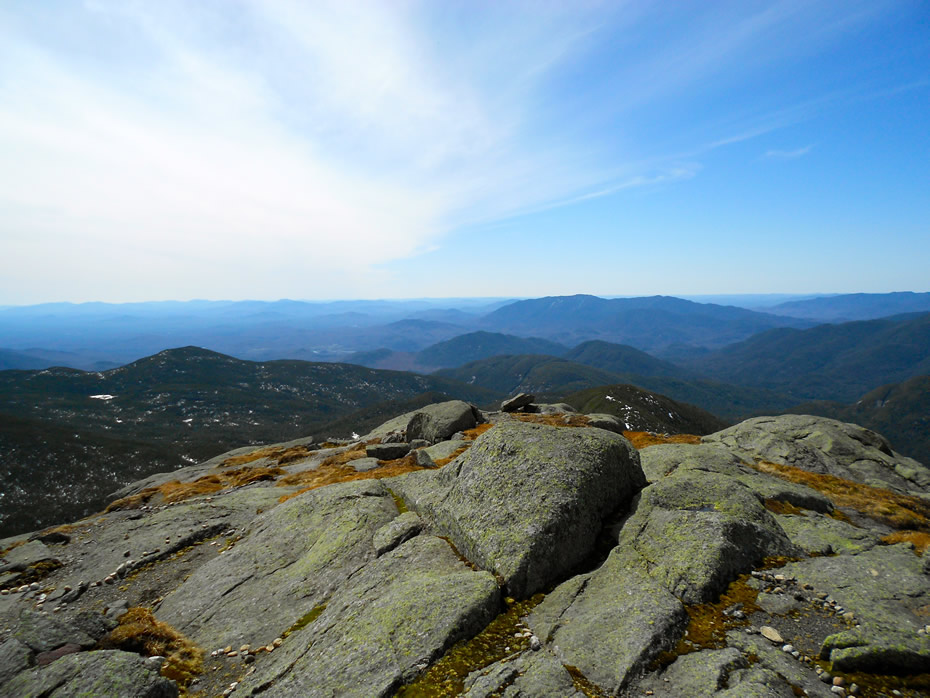
The summit of Mt. Marcy. / photo: Casey Normile
The Adirondacks -- the High Peaks especially -- have been a very popular spot for hikers over the last decade or so. And that's resulted in all sorts of related issues, from crowding to trash to parking problems.
This week the state Department of Environmental Conservation announced it's taking up "a multi-year, comprehensive effort to promote sustainable tourism, and address public safety in the Adirondacks." Press release blurbage (emphasis added):
Popular destinations on DEC lands within the Adirondack Park such as the High Peaks, Dix, Giant and Hurricane Wildernesses, Baxter Mountain, and the Saranac Lake 6'er peaks, are attracting an unprecedented number of users.
To improve public safety and reduce impacts to natural resources in the area, DEC held four focus group meetings this past winter to generate ideas and information to support recommendations, particularly to address overuse challenges in the High Peaks region and the Route 73 corridor between Exit 30 of the Northway and Lake Placid in the Adirondacks. The meetings were held in partnership with the towns of Keene and North Elba and involved a wide range of stakeholders. With input from DEC land managers, the meetings helped the agency identify specific strategies and actions to be taken in 2018 and 2019.
Actions along the Route 73 corridor are scheduled to start during the July 4th holiday week and are being implemented with state agency partners and municipalities. The first phase of actions include:
No. No. No. No. No. No. No.
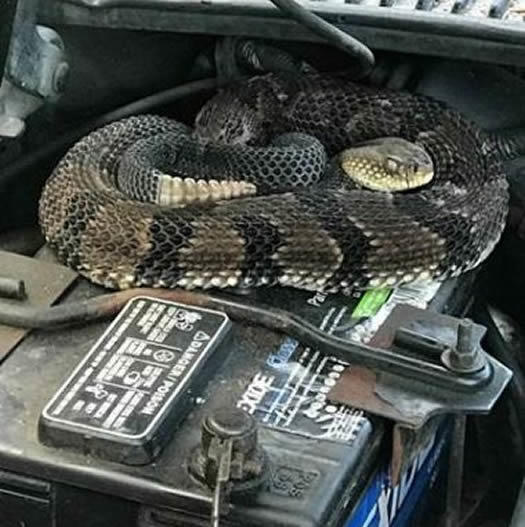
And to repeat: No. Nope. No. No. No. / photo: NYSDEC
Tucked in at the end of a state Department of Environmental Conservation digest of agency police officer encounters -- titled "Strange Rattle in the Engine - Delaware County":
On June 11, Lt. Nate Ver Hague and ECO Mark Vencak responded to a complaint of a rattlesnake resting on an engine block in the town of Hancock. The complainant told them that he had opened the hood of his car to jump start the vehicle and heard the distinctive rattle of a snake. He backed away and saw a large rattlesnake resting in the center of the engine block. Disturbed, the snake slithered over to the battery and curled up there. The officers confirmed the snake was a timber rattlesnake seeking shelter. ECO Vencak carefully extracted the snake from the engine compartment as Lt. Ver Hague untangled the tail wrapped around part of the engine. The officers released the snake nearby, next to several large boulders - a much more snake-appropriate habitat.
Why did it have to be snakes.
Timber rattlesnakes are New York State's largest venomous snake -- here's the DEC fact sheet on them. ("Timber rattlers impress one as being very stocky..." Hey, no judgements.) And here's a somewhat old DEC map of their distribution around the state. Their populations are mainly clustered in the southeast part of the state from the southern Catskills to the state border, though there are also some populations near Lake George and Lake Champlain.
All freaking out aside, snakes are an important part of ecosystems, often acting as predators on rodent populations. And New York State is home to 17 species of them, according to an info page from SUNY ESF. Three of those species are venomous -- "All three are uncommon."
[via @GannettAlbany]
Spotting the spotted lanternfly

There is an insect called the spotted lanternfly. It's an invasive species here in the United States. And the state Department of Environmental Conservation would like you to report if you see one around here.
DEC reasons blurbage (emphasis added):
SLF pose a significant threat to New York's agricultural and forest health. Adults and nymphs use their sucking mouthparts to feed on the sap of more than 70 plant species. This feeding by sometimes thousands of SLF stresses plants, making them vulnerable to disease and attacks from other insects. SLF also excrete large amounts of sticky "honeydew," which attracts sooty molds that interfere with plant photosynthesis, negatively affecting the growth and fruit yield of plants. New York's annual yield of apples and grapes, with a combined value of $358.4 million, could be impacted if SLF enters New York. The full extent of economic damage this insect could cause is unknown at this time.
Although native insects also secrete honeydew, the size of SLF and the large populations that congregate in an area result in large accumulations of it. The sticky mess and the swarms of insects it attracts can significantly hinder outdoor activities. In Pennsylvania, where SLF populations are the densest, people can't be outside without getting honeydew on their hair, clothes, and other belongings.
Ew. Also: the term "sucking mouthparts."
Fish from the sky
From the "Jobs We Didn't Know Existed" file: Aerial fish stocking.
The short clip embedded above is state Department of Environmental Conservation video about its work stocking lakes and streams in remote parts of the Adirondacks -- sometimes by helicopter or plane.
From the DEC's website:
Each year DEC releases approximately 900,000 pounds of fish into more than 1,200 public streams, rivers, lakes and ponds across the state. These fish are stocked for two main purposes-- to enhance recreational fishing and to restore native species to waters they formerly occupied.
Raising these fish is a big task that requires precise methods and specialized equipment and facilities. The DEC runs 12 fish hatcheries, each specializing in raising one or more species of fish, including brook trout, brown trout, rainbow trout, lake trout, steelhead, chinook salmon, coho salmon, landlocked salmon, walleye, muskellunge and tiger muskellunge.
Here's the 2018 list of the bodies of water in which the DEC releases fish.
Earlier: There's a moose... and there's a moose... and there's a moose...
The State Museum coyote is free
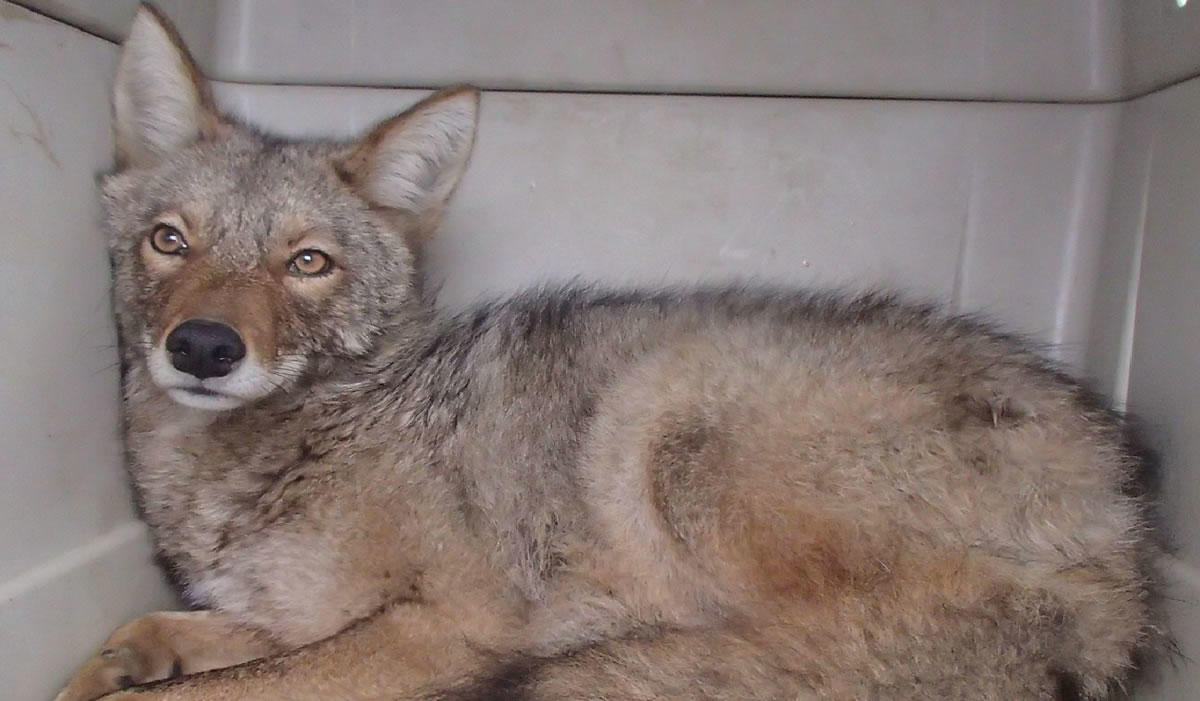
The coyote ahead of its release back into the wild. / photo: NYS DEC
Good news: The state Department of Environment Conservation says the coyote removed from the State Museum terrace Tuesday has been released back into the wild. There's a photo and video from the release below.
DEC says biologists at the agency's Wildlife Health Unit in Delmar checked out the coyote before the release Wednesday morning and concluded the animal was in good health.
As we noted yesterday, it's not all that surprising that a coyote would turn up around the Empire State Plaza -- they slip through urban and suburban areas often. But finding one hanging out in a place like that during the day is odd. So what happened?
Moose spotting
The state Department of Environmental Conservation is doing another aerial survey of the moose population in the Adirondack Park. And, of course, there are photos -- that's one of them above (more at the link).
See also: DEC's Flickr gallery of moose photos.
DEC says that early results point to the moose population being about 400 in the park.
Here's an info page on moose in New York, along with details about how to report a moose sighting.
By the way: moose are very big and strong and should be given plenty of distance.
Earlier:
+ There's a moose... and there's a moose... and there's a moose...
+ Mesmerizing moose
Turtle time
 The state Department of Environmental Conservation would like to remind you that "the state's native turtles are on the move in May and June seeking sandy areas or loose soil to lay their eggs" -- and to urge people to watch out for them while driving. From a "What can I do to help?" list:
The state Department of Environmental Conservation would like to remind you that "the state's native turtles are on the move in May and June seeking sandy areas or loose soil to lay their eggs" -- and to urge people to watch out for them while driving. From a "What can I do to help?" list:
+ If you see a turtle on the road, please try to avoid hitting it with your car. Do not swerve suddenly or leave your lane of travel, but take care to avoid hitting turtles while driving to "give turtles a brake".
+ Be on the lookout for turtles and slow down, especially on roads near rivers and marshy areas.
+ If you see a turtle in the road or shoulder and you can safely stop your vehicle and approach the turtle, please consider moving it to the shoulder on the side of the road in the direction it is facing.
+ Picking the turtle up by its tail may frighten or injure it. Most turtles, other than snapping turtles, can be picked up by the sides of its shell.
+ Use extreme caution when approaching snapping turtles. You could:
+ stand watch as she finishes crossing,
+ pick her up at the rear of the shell near the tail using both hands, or
+ slide a car mat under the turtle to drag her safely across the road. See a video of how to help a snapping turtle cross the road (leaves DEC website).
+ Do not take the turtle home. All turtles native to New York are protected by law and cannot be collected without a permit.
There are 11 native species of land turtles in New York, according to DEC, which says the populations of each are in decline.
It's a hoot
Noted: The state Department of Environmental Conservation has an Instagram account.
It includes many good photos of birds (owls) and other animals (moose) from around the state.
That is all.
Instead of the High Peaks this autumn...
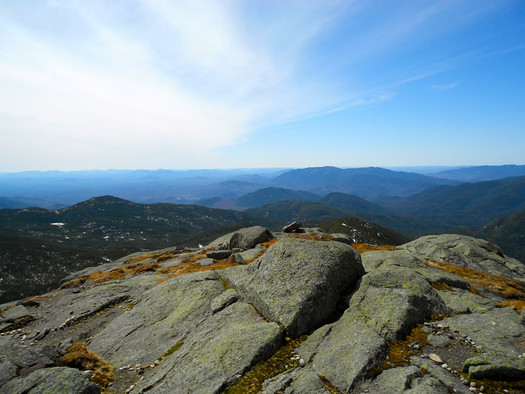
Maybe leave the High Peaks for another time. / photo: Casey Normile
Autumn is a prime hiking season -- the warm sun and cool air makes for comfortable weather, and of course, there's the foliage.
But this fall the state Department of Environmental Conservation has a request: Think about not hiking the popular High Peaks in the Adirondacks. From a DEC press release this past Friday:
This autumn hikers should properly prepare for hikes in the Adirondacks and hike on trails less populated than those in the High Peaks Wilderness, an opportunity that offers fantastic scenes of fall foliage for a more enjoyable backcountry experience, New York State Department of Environmental Conservation Commissioner Basil Seggos urged today.
"Autumn is a great time to enjoy the Adirondacks," Commissioner Seggos said. "As more people continue to enjoy the incredible outdoor excursions offered throughout the Adirondack Park, we encourage visitors to explore the hundreds of lesser known trails that offer the same high quality natural experiences as the more popular trails, and to be prepared to safely enjoy the Park's changing conditions."
Toward that goal, DEC is offering a dozen different hikes in the Adirondacks as alternatives.
We've taken the DEC's suggestions and put together a clickable map with with brief descriptions of each -- have a look.
Earlier on AOA: How to get started hiking the High Peaks: Part I and Part II. Many of Cristin's suggestions hold for non-High Peaks, too.
(Thanks, SM)
They haven't gone bald yet
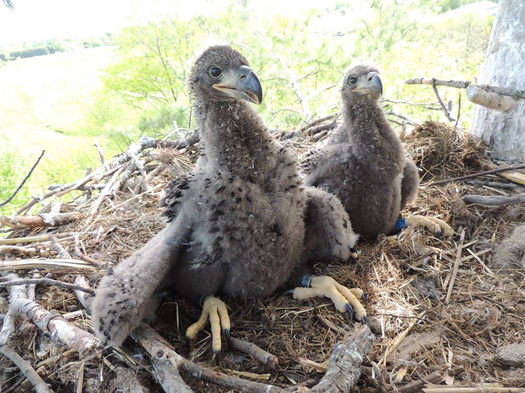
That pic above is a pair of bald eagle chicks that biologists from the state Department of Environmental Conservation recently banded in Albany County. From a DEC Facebook post:
Using band data, DEC biologists can track the birds age, movement and dispersal activity. The silver band is a federal ID band that is tracked by the U.S. Geological Survey (USGS) while the blue band is a New York State ID band.
From a distance you can sometimes see the colored band and at least know that that bird was born in New York. With a good spotting scope it's also possible to read the letter and two digit number code when the bird is perched. That data can be reported to DEC biologists and we can track their movement.
That link above includes more photos of the chicks and their nest.
Bald eagle populations had been almost entirely wiped out in New York State by the 1960s, in part because of an insecticide called DDT that weakened the shells of birds of prey. (Museum specimen collections such as the one at the New York State Museum helped biologist figure that out.) The pesticide was banned in the early 1970s. And in 1976 a program aimed at re-establishing bald eagles in New York State started relocating young eagles from other parts of the county, and it helped rebuild the population in the state -- and it's still growing.
Earlier on AOA: What, your job doesn't involve baby bears?
photo: NYS DEC
The Atlas of Inland Fishes of New York

There are 181 native and introduced freshwater fish species in New York State.
That's one of the many, many bits in a huge new catalog of the state's fish released this week as part of joint effort by the New York State Museum and the state Department of Environmental Conservation. It's the first such publication in three decades.
The book is available to download for free as a pdf from the State Museum website.
The Atlas of Inland Fishes of New York is pretty much exactly what it sounds like. It includes photos or illustrations of each of the state's different fish species, along with maps depicting where the fish have been found both in the past and present. As the atlas preface notes of New York: "its freshwater fish species represent one of the richest and most scientifically fascinating ichthyofaunas in the Northeastern United States."*
It's fascinating to flip through the atlas, gawking at some of the wildly-colored or shaped fish, and seeing how they compare or contrast with other similar fish. It's also interesting to see the geographic ranges of each species plotted -- how some species live only in a few river corridors, others are confined to specific watersheds, and others are pretty much everywhere.
And if nothing else, some of the names are great: Gizzard Shad, Central Stoneroller, Northern Redbelly Dace, Tonguetied Minnow, Rosyface Shiner, Bigeye Chub, Northern Hog Sucker, Threespine Stickleback, Pumpkinseed, Tesselated Darter, and so on...
* "Scientifically fascinating ichthyofaunas" really should be some sort of state marketing slogan.
A big bucket of water for a big fire
If you'd like to speed through the clip, you can switch it on 2x speed by click the gear icon.
Farther afield: Check out this video of a helicopter dropping water on the large wild fire in the Sam's Point Preserve in Ulster County earlier this week -- it was posted by the NYS Department of Environmental Conservation. The agency has also posted photos from the burned-out area. They're eerie.
By the way: That bucket suspended from the helicopters is called a "Bambi Bucket", and it was dropping 250 gallons, according to DEC's description.
Rain this week helped knock down the fire, and as of late Wednesday officials said it was 60 percent contained and they were focused on remaining spots that were still smoldering. The fire had burned roughly 1,900 acres (that's almost 3 square miles), according to DEC estimates. [Times Herald-Record]
What, your job doesn't involve baby bears?

Oh, hello, there...
Filed under "jobs we didn't know existed" and "the cuteness is too much": Biologists with the state Department of Environmental Conservation have been visiting bear dens around the state to gather data about bear populations in New York. And that process involves (temporarily) removing bear cubs from the dens so they can be weighed.
This week the DEC posted photos from one of these recent den visits -- in Allegany State Park -- on its Facebook page. That's one of the pics above. A clip from the post:
The 173-pound sow was ear-tagged and fitted with a GPS tracking system collar. The collar collects GPS points at set intervals, then sends the location via text messages - so even bears are getting in on texting these days! DEC staff carefully monitored the sow's vitals during the process. The bandana is used to protect her eyes while she is immobilized.
During this time, the three cubs were ear-tagged and weighed only. There were 2 males and 1 female bear cub. The cubs were fairly small (3-4 pounds each) and healthy, probably meaning they were born in late January. After the work was done, the sow is placed back in the bear den with her cubs, where they will stay until the cubs are big enough to keep up with their mother in the woods, typically another few weeks.
DEC says it will be sharing more from these bear den visits over the next week.
Black bear populations in New York State have "increase[d] dramatically in number and distribution in recent decades," according to state's Black Bear Management Plan published in 2014 -- and there are now more than 6,000 bears estimated to be in the state, across large portions of upstate.
Earlier on AOA:
+ Don't feed the bears
+ There's a moose... and there's a moose... and there's a moose...
photo: NYS DEC
There's a moose... and there's a moose... and there's a moose...
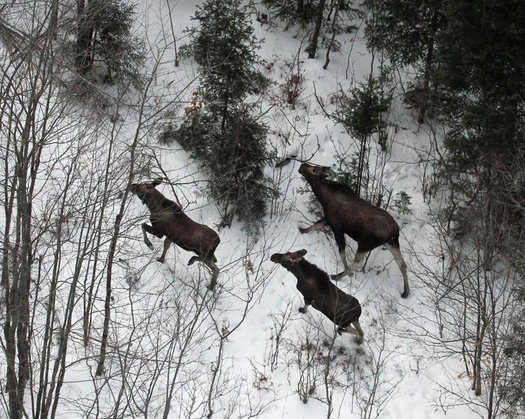
From the "Jobs You Didn't Know Existed, But Now That You Do, You Really Want That Job" file: The state Department of Environmental Conservation posted photos on Facebook today from helicopter survey flights of moose in the Adirondacks (that's one of the photos above). It's part of the agency's ongoing effort to study the state's moose population:
Nine additional cow moose were recently captured, collared and released as part of a multi-year moose study. There are now a total of 21 moose, including 18 cows, fitted with GPS/radio collars. Their locations are monitored weekly.
DEC wildlife staff also flew helicopter survey flights throughout the #‎Adirondacks to locate and observe moose. ...
In 2015, more than 165 moose sightings were reported by the public. The map indicates the towns in which moose were reported. DEC encourages people to continue to submit moose sightings and moose sign, (tracks, scat and scrapings) using the form at the bottom of the Moose web page
Here's a DEC map of public moose sightings in 2015. You can see they're largely concentrated in the Adirondacks. But the animals do show up in the Capital Region from time to time, especially in Rensselaer and Saratoga counties. There was that moose in Halfmoon a few years back, and the moose spotted at the Saratoga Race Course a few years before that.
DEC has reported in the past that scientists have collected evidence indicating moose populations in New York State have grown considerably during the last few decades -- from as few as 50 to 500 or more in recent years.
Earlier on AOA: Mesmerizing moose
photo: NYS DEC
Bear cub rescue
Because it's video of a bear cub being rescued. From the state Department of Environmental Conservation FB page:
[Tuesday] morning, Environmental Conservation Officer Anthony Glorioso was called to Windham Mountain Village (WMV) in the town of Windham where a bear cub was stuck in a tree high above ground. With the assistance of a local construction company's boom crane, Officer Glorioso went 65 feet up to get a better look at the situation. The officer attempted to free the cub but quickly saw his neck was stuck. Once the "v" was cut out of the tree using a chain saw, Officer Glorioso grabbed the cub and brought it into the bucket. As soon as the bucket came down, the cub ran back into the wooded area.
The Watershed Post talked with the townhouse development's property manager about the situation -- the bear had been stuck in the tree since Monday and had been calling for its mother.
The Albany bear falls to the ground

A still from a video clip shortly after the bear fell from the tree.
Updated 5:10 pm
The black bear that had been caught in a tree in Albany since Tuesday fell to the ground Wednesday just before 1 pm after being hit with tranquilizer darts. The state Department of Environmental Conservation reported later Wednesday afternoon that the bear had been euthanized.
A statement from DEC director of media relations Emily DeSantis:
The state Department of Environmental Conservation strives to relocate wildlife in situations where they enter urban and suburban settings. In this case, wildlife biologists determined this course of action is more humane and necessary to preserve public safety because of the bear's injuries and its history of returning to urban and suburban settings.
The video still above is from the scene just after the bear hit the ground. A witness sent the video to AOA -- the full clip is posted after the jump (thank you, Dawn). While not graphic, the video is a bit hard to watch knowing the context.
Gobble, gobble, gobble

A wild turkey in Albany's Buckingham pond neighborhood in summer 2012.
The state Department of Environmental Conservation says wild turkey populations have declined in many parts of the state over the last decade. In an effort to figure out why, DEC is planning to capture some hens to fit them with ID bands -- and in some cases, satellite radio-transmitters. DEC is also asking the public to report wild turkey sightings via a survey.
It's estimated that the wild turkey population in New York State could be as large as 300,000. And it's not uncommon to see them around the Capital Region -- we've seen them a bunch of times in residential neighborhoods in the city of Albany. But turkey's weren't always so common here -- at least, at one time. From a DEC backgrounder on wild turkeys:
The wild turkey is native to North America. Turkeys were widespread when the Europeans arrived and may have predated the earliest human inhabitants. At the time of European colonization, wild turkeys occupied all of what is currently New York State south of the Adirondacks.
Turkey habitat was lost when forests were cut for timber and turned into small farms. The early settlers and farmers also killed wild turkeys for food all year round, since there were no regulated hunting seasons at that time. The last of the original wild turkeys disappeared from New York in the mid-1840's. By 1850, about 63 percent of the land in New York was being farmed. This trend continued until the late 1800s when about 75 percent of New York State was cleared land.
In the early 1900s farming began to decline. Old farm fields, beginning with those on the infertile hilltops, gradually reverted to brush land and then grew into woodland. By the late 1940s, much of the southern tier of New York was again capable of supporting turkeys. Around 1948, wild turkeys from a small remnant population in northern Pennsylvania crossed the border into western New York. These were the first birds in the state after an absence of 100 years.
The state's wild turkeys are descendants of those migrants from Pennsylvania.
In studying what's up with wild turkeys, the DEC shouldn't rule out that the birds have just decided to go back to school (you know, because of the economy). Back in September a turkey expressed interest in attending Mater Christi in Albany.
Earlier on AOA: Wild about turkeys
Um, where are my antlers?

Kind of like waking up to find out that someone cut your hair.
Today's moment of moose: The Department of Environmental Conservation posted a photoset from today's moose re-location in Halfmoon. After tranquilizing the moose and getting him loaded into the trailer for transport to the Adirondacks, the moose apparently decided to pose for a portrait. (And then he stared into our soul.)
What happened to the antlers? The DEC says it removed the moose's antlers to minimize injury during transport. (Meese* drop their antlers around the start of winter and regrow them in the winter spring, anyway.)
* Yes, we know that's not the plural. But it should be.
Noted: state's official position on Bigfoot
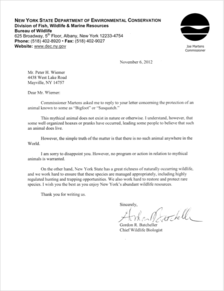 We were forwarded this letter Tuesday by Peter Wiemer, director of the Chautauqua Lake Bigfoot Expo. It's correspondence from the state Department of Environmental Conservation regarding Wiemer's concerns that bigfoots* currently don't have strong enough protections from hunting, especially considering a recent $10 million bounty on sasquatch:
We were forwarded this letter Tuesday by Peter Wiemer, director of the Chautauqua Lake Bigfoot Expo. It's correspondence from the state Department of Environmental Conservation regarding Wiemer's concerns that bigfoots* currently don't have strong enough protections from hunting, especially considering a recent $10 million bounty on sasquatch:
Dear Mr. Wiemer,
Commissioner Martens asked me to reply to your letter concerning the protection of an animal known to some as "Bigfoot" or "Sasquatch."
This mythical animal does not exist in nature or otherwise. I understand, however, that some well organized hoaxes or pranks have occurred, leading some people to believe that such an animal does live.
However, the simple truth of the matter is that there is no such animal anywhere in the World.
I am sorry to disappoint you. However, no program or action in relation to mythical animals is warranted.
On the other hand, New York State has a great richness of naturally occurring wildlife, and we work hard to ensure that these species are managed appropriately, including highly regulated hunting and trapping opportunities. We also work hard to restore and protect rare species. I wish you the best as you enjoy New York's abundant wildlife resources.
Thank you for writing us.
Sincerely,
Gordon R. Batcheller
Chief Wildlife Biologist
We contacted DEC about the letter and agency spokesman Rick Georgeson confirmed it's real. Also: "We have no further comment on this issue."
Earlier correspondence between Mr. Wiemer and DEC indicated that if sasquatch were real, they would be protected by state law. Good to know.
From Mr. Weimer's press release this week: "We have had nine eyewitnesses to date, of Bigfoot sightings in Chautauqua County come forward resolving themselves of the burden of knowing what they saw and were afraid of or not willing to tell because of fear of ridicule. All but one wished to remain anonymous."
Update: The TU's Casey Seiler talked with Wiemer about his concerns.
By the way: The second Chautauqua Lake Bigfoot Weekend & Expo is scheduled for for April 26, 27, and 28. Well played, Mr. Wiemer.
... said KGB about Drawing: What's something that brought you joy this year?